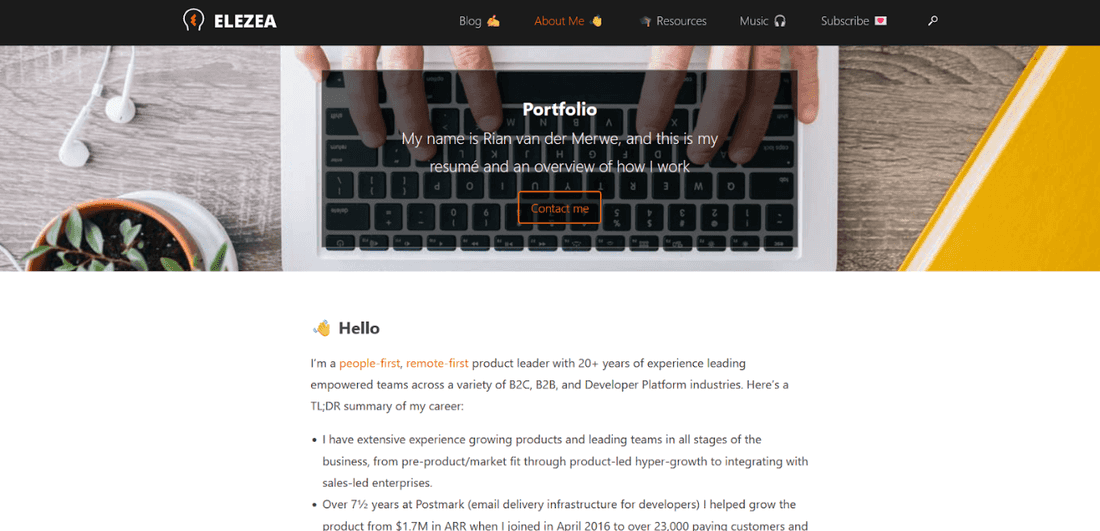How to Make a Product Manager Portfolio +Examples
So, you’re in the product management game—it’s where you shine. Maybe “Product Manager” is emblazoned on your business card, or perhaps you go by a different title that doesn’t quite do justice to all those plates you keep spinning.
You’ve got skin in the game with several products to your name, and guess what? When hunting for that next opportunity, hiring managers will want the scoop on those wins of yours.
The key to nailing this lies in crafting an impressive product manager portfolio. Think of it as a curated exhibit of what makes you brilliant at being a PM.
Here’s our agenda:
- Explain exactly what we mean by ‘product manager portfolio’
- Walk through building one from scratch
- Peek into some real-world portfolios that hit the mark
Gear up! The spotlight’s about to shine on your best moments as we guide you through piecing together an ace PM portfolio.
What is a Product Manager Portfolio?
Your product manager portfolio showcases the outcomes that had a lasting impact while working on a certain product or project.
Think of your Product Manager portfolio as less of a brag sheet and more like the ultimate proof of your product mastery. This is where you show how you took ideas, gave them life, and made them stars in the marketplace.
Inside this portfolio is the narrative of what you’ve handled along your career path—whether that’s taking one killer product under your wing or juggling multiple lines—and exactly how your strategic thinking turned those concepts into profits and wins.
Why Have a Product Manager Portfolio at All?
Here’s the straight talk on why having a product manager portfolio is a must-have:
1. Walking Proof
Sure, anyone can claim they’re hot stuff in product management—but can you back it up?
That’s where a portfolio comes into play. It showcases your track record for all to see. It’s solid evidence of your knack for shepherding ideas into profitable products that wow customers and leave competitors playing catch-up.
When you come armed with a portfolio that highlights successful products under your belt, you’re not just saying you’ve got a serious game, you’ve actually got the scorecard to prove it.
2. Moving Up the Ladder
Hunting for a promotion or eyeing that corner office? Your resume gets your foot in there, but a sharp portfolio is what actually lands you in the chair.
Think of it as turning up to court, but you’ve actually brought evidence. It shows potential bosses not just your job history, but also how you’re going to move their business forward.
A portfolio lays out your ambitions and proves them with a trail of achievements and impact—you know, real wins from the trenches.
3. Visibility and Branding
Your portfolio is essentially your career narrative. It transcends the resume to embody your professional identity through design elements—think color schemes, distinct logos, typography—the works.
If in doubt, ask the folks on your team responsible for marketing just how important this stuff is.
These tailored features ensure that when someone reviews your work, they’re not just seeing accomplishments, they’re experiencing your brand in full force.
Having this curated collection differentiates you within an overcrowded field and proactively presents yourself to colleagues, headhunters, and thought leaders.
More than enhancing visibility, it showcases specific talents and histories that pave the way for targeted opportunities that resonate with where you want to take your career trajectory.
4. Personal Progress Check-In
Think of your portfolio as more than just bragging rights material—it’s essentially your career mirror.
It lays out all you’ve done, warts and all, pushing you to take an honest look at your work history.
- What did you nail?
- Where did things go sideways?
- How did you come out on top?
A portfolio is that frank friend who tells it like it is, showing off your wins but also nudging you towards what needs a bit of polish for next time around.
Remember, it’s not navel-gazing. It’s strategic self-improvement—crucial for staying sharp in this game.
5. Making Connections
A solid product manager portfolio isn’t only about showing off past successes—it’s your invite to the networking party.
It opens doors for banter and can kickstart chats at various professional gatherings, be it over coffee or during more formal events like interviews. Displaying your prowess might just catch someone’s eye, leading them down the path of proposing joint ventures or inviting you onto their stage.
6. Staying Sharp and Ready
Finally, keeping your portfolio fresh means you’re perpetually interview-ready—no last-minute madness required.
It positions you as primed to flaunt what you’ve got when that next big break taps on your shoulder out of nowhere.
Making a Product Portfolio as a Product Manager in 6 Simple Steps
Developing a standout product manager portfolio may not be the most complex task you’ll face, but it still calls for some solid planning.
So, here’s a clear-cut guide divided into six key steps.
These will assist you in building a portfolio that effectively showcases your experiences and achievements within product management while highlighting your impact and strategic prowess.
Step 1: Identify Your Showcase Products
First up, let’s sift through your projects and handpick the ones that scream success.
We’re not trying to inflate your portfolio like a balloon here, we want those heavy hitters to show off why you’re in this game.
Grab those products or initiatives where you can point out, “Yep, I moved mountains there.” Aim for a mix. Maybe one cracked open a tough market while another pulled an all-nighter of coding.
You get bonus points if it was on the brink of failure and now it’s everyone’s darling thanks to your PM skills. In essence, we’re setting up a display window with enough variety to say, ‘I’ve got more than one trick up my sleeve.’
Step 2: Document Key Metrics
For every product in your range, pinpoint and document the metrics that truly matter. Consider which stats made a real difference. Was it an uptick in earnings, broader market reach, or maybe user base growth?
These numbers tell a compelling story about your product’s performance and reflect on your leadership. Record these key metrics thoroughly. They’re strong evidence of how well you’ve managed and improved each product.
It’s critical to demonstrate clear outcomes beyond merely completing tasks. You need hard facts that showcase your outstanding achievements.
Step 3: Highlight Your Role
Lay out what you brought to the table without leaving room for guesswork. Did you navigate through a dicey market period, or did you pivot the product strategy when it mattered most?
It’s your job here to pinpoint exactly what you did, outline the strategies that were all yours, and tag them with their outcomes. This slice of your portfolio is where your personal brand shines, so don’t let anyone miss it.
If there’s something niche up your sleeve—maybe driving growth in online sales or revamping user experience design—make sure these accomplishments have their own spotlight.
Show how those skills impacted broader victories because this is about demonstrating why teams are better with you on board.
Step 4: Outline Challenges and Solutions
Ever had a product launch without a single hitch? Neither have we.
Every product journey is peppered with its fair share of complications, and this step is where you shine by demonstrating how you wrangled those issues.
Pinpoint the biggest headaches in your projects—no sugarcoating—and elaborate on exactly what steps you took to tackle them head-on.
Here’s where fluff won’t fly. Talk about real challenges met with smart, practical solutions. By divulging these trials and your tactical approach, you not only reveal your tenacity but also underscore your knack for quick-thinking and steering clear of disaster even when under fire.
It’s all about showing off how well you pivot from problem-laden scenarios to triumphant wins.
Step 5: Include Testimonials and Endorsements
We know you’re good at what you do, and more importantly, others do, too. So, let’s not make your portfolio a solo show of self-praise.
Bring in the voices that matter:
- Colleagues who’ve seen you in action
- Bosses who nodded approvingly at your results
- Customers whose days you made better
Their words are like gold. They turn “good job” into “wow factor.” Make sure these snippets of praise aren’t tucked away somewhere shy but front and center where they rightly belong. Essentially, treat your portfolio like a landing page, those success stories should be front and center, and impossible to miss.
Step 6: Get It Out There and Keep It Updated
Your portfolio isn’t set in stone. Update it regularly to reflect your new achievements and phase out the older examples that don’t quite represent where you are now. This ensures your portfolio keeps pace with your evolving career trajectory.
But just having an up-to-date portfolio isn’t enough—you’ve got to get eyes on it.
Set up a simple website or beef up your LinkedIn page as a showcase for your projects. Use easy, no-code platforms or tools that let you transfer product case studies straight from where you work them out into the public eye.
By doing this, not only do you boost how many people see what you’re capable of, but also show off how savvy you are with today’s digital toolkit—another feather in your cap for potential collaborators or employers to notice.
Four Examples of Product Portfolios Done Right
Talking about what makes an impressive product manager portfolio is helpful, but it’s another thing to see actual examples that knock your socks off.
Here, we’re taking a look at four standout portfolios from some seriously smart product managers. These aren’t just by-the-book cases. Each brings its own flavor and shows off how these PMs think and deliver results.
1. Juan J. Ramirez

At whoisjuan.me, Juan J. Ramirez offers a straightforward yet engaging peek into his world as a Product Designer who doesn’t just understand users but gets technology too – on a first-name basis, it seems.
His portfolio isn’t shy about showcasing the heavy hitters he’s worked with (hello AWS and LIFX) or the brainpower he honed at Carnegie Mellon University.
It’s not all show, there are thoughtful blog entries and project rundowns that don’t just talk about successes but walk you through them with enough visuals to make anyone pay attention without dozing off from another boring presentation.
2. Rian van der Merwe

Rian’s portfolio at elezea.com is an impressive display that merges clear visual elements with detailed career insights. With two decades’ worth of experience steering the product ship in several sectors, he showcases his work in a way that communicates more than your average CV.
The organization here is spot on. It’s easy to navigate, and you can see all the products he’s championed, complete with engaging visuals that trace his professional path and involvement from concept to launch.
His portfolio stands out by clearly illustrating what he has achieved and how each product flourished under his direction, without skimping on substance or style—the thoughtful case studies are proof of this man’s knack for making things happen.
The images included make sure you’re seeing rather than just reading about his influence in the field.
3. Danka Ha

Over at dankaha.webflow.io, you’ll find a masterclass in brevity from Danka Ha’s product management portfolio.
Navigation is a breeze—no excess fluff to wade through—and it gets straight to the point. Here, her tour of duty with big names like Facebook and Infinto takes center stage without any needless fanfare.
It’s just pure highlights of how she’s helped sculpt workplaces and fintech offerings into better versions of themselves.
The best feature is a no-nonsense contact form sitting pretty at the bottom for folks eager to reach out, paired with crisp snapshots of her skillset and studies-in-progress that serve as open invitations for network-building chats.
In essence, this portfolio nails its mission: Delivering Danka’s professional story with crystal-clear precision.
4. Sherlaine Lau

Sherlaine Lau’s portfolio is a prime example of mixing personal branding with solid product management skills.
Her website kicks off with an eye-catching video introduction that pulls you right in. It’s slick, it’s professional, and it doesn’t waste your time.
You get a sense of who she is not just professionally—with her track record at big names like Microsoft—but also personally: Coffee and pets? Relatable.
It nails the sweet spot: Showcasing technical expertise while still feeling human. Sherlaine gets how to present herself as both accomplished and down-to-earth. It’s a smart move for any product manager looking to stand out without coming across as too buttoned-up or distant.
Best Tools to Create a Product Portfolio
There are plenty of neat tools you can use when creating your product portfolio. If you don’t want to make it a hassle, you can always whip out your trusty Word document or Google Doc — for everyone else, here are a few more intuitive options:
Fibery
Getting started is easy, and you can link everything with everything using relational databases. Your product portfolio will be an eye candy and a pleasure to navigate as well.
What’s even better is that you can have a 14-day free trial to see things for yourself.
Notion
Lauded for its tidy and crisp look, Notion is a fan favorite (at least when it comes to PMs). Loved for its editing experience and shallow learning curve, getting started (and perfecting) your portfolio in Notion is a no-brainer.
Medium
It’s SEO-friendliness and community-boosted platform can help your portfolio reach further than you’d imagine. Editing a single page is a great experience, although more complex page structures can get a bit messy.
Wordpress
If you know it, you know it can do it all. Even a PM portfolio. If you don’t, you might have a tough time getting started: rookies often find it difficult to create things in WP just as they imagined. Still, if you have time to explore things, you can create something that is truly unique.
The PM’s Hot Take
As a product manager, you live and breathe the ins and outs of your products—what needs to happen, who’s involved, when it should all come together, and how to roll it out without a hitch.
But guess what? Talking up yourself can be way harder than juggling those project timelines. Crafting that portfolio means turning the spotlight on yourself—and let’s be honest—it feels weird.
It turns out that nailing down your own wins is often more challenging than keeping track of features or squashing bugs in the daily product management chaos
Conclusion
Alright, let’s wrap this up. You’ve got the plan in hand, now roll up your sleeves and get to work on that portfolio of yours.
Remember, it’s not just a highlight reel of wins—it’s your career story, showcasing how you think and get stuff done.
Use what we talked about here and build a portfolio that screams ‘you’ all over it.
Need more tips? Keep an eye on the Fibery blog for fresh takes on product management finesse.
Time to give your career a serious boost.
FAQ
Q: What should be in a product manager portfolio?
Your portfolio should be a curated showcase of your PM wizardry. Think your greatest hits, but for products. Include standout projects, brass-tack metrics showing off your wins, any dragons you’ve slain (figuratively speaking), and the savvy choices that got you there.
Don’t forget to pepper in kudos from colleagues and snapshots or artifacts that put your achievements in the spotlight.
Q: What does a product portfolio manager do?
Picture someone at mission control for products, that’s our product portfolio manager. Their radar is lit up with all sorts of projects, and they’re making sure everything flies right – on brand track, with market-friendly skies ahead. They’re dealing out resources and keeping tabs on how these bets are panning out to shuffle priorities around when needed.
Q: How to create a PM portfolio?
Roll up those sleeves - it’s time to craft your own legend in project form. Handpick the best of what you’ve worked on. Detail what was aimed for, how you steered things, hit markers along the way, and insights picked up during the journey.
Bring numbers into play because nothing says “I did this” louder than cold hard data. Round it all off with some applause from peers or clients who can vouch for your feats.
Q: How to build a product management portfolio with no experience?
No battle scars in PM yet? No worries! Raid through academic work or side gigs where you flexed related muscles—think strategy calls made, goals scored (even small ones count). Lay down a path from problem land to resolution territory as though walking through hypotheticals while showcasing command over potential real-world scenarios.
Psst... Wanna try Fibery? 👀
Infinitely flexible product discovery & development platform.